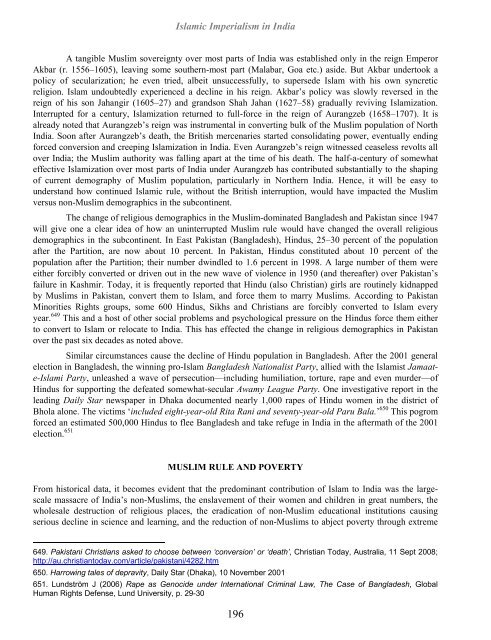islamic-jihad-legacy-of-forced-conversion-imperialism-slavery
islamic-jihad-legacy-of-forced-conversion-imperialism-slavery
islamic-jihad-legacy-of-forced-conversion-imperialism-slavery
- No tags were found...
You also want an ePaper? Increase the reach of your titles
YUMPU automatically turns print PDFs into web optimized ePapers that Google loves.
Islamic Imperialism in IndiaA tangible Muslim sovereignty over most parts <strong>of</strong> India was established only in the reign EmperorAkbar (r. 1556–1605), leaving some southern-most part (Malabar, Goa etc.) aside. But Akbar undertook apolicy <strong>of</strong> secularization; he even tried, albeit unsuccessfully, to supersede Islam with his own syncreticreligion. Islam undoubtedly experienced a decline in his reign. Akbar’s policy was slowly reversed in thereign <strong>of</strong> his son Jahangir (1605–27) and grandson Shah Jahan (1627–58) gradually reviving Islamization.Interrupted for a century, Islamization returned to full-force in the reign <strong>of</strong> Aurangzeb (1658–1707). It isalready noted that Aurangzeb’s reign was instrumental in converting bulk <strong>of</strong> the Muslim population <strong>of</strong> NorthIndia. Soon after Aurangzeb’s death, the British mercenaries started consolidating power, eventually ending<strong>forced</strong> <strong>conversion</strong> and creeping Islamization in India. Even Aurangzeb’s reign witnessed ceaseless revolts allover India; the Muslim authority was falling apart at the time <strong>of</strong> his death. The half-a-century <strong>of</strong> somewhateffective Islamization over most parts <strong>of</strong> India under Aurangzeb has contributed substantially to the shaping<strong>of</strong> current demography <strong>of</strong> Muslim population, particularly in Northern India. Hence, it will be easy tounderstand how continued Islamic rule, without the British interruption, would have impacted the Muslimversus non-Muslim demographics in the subcontinent.The change <strong>of</strong> religious demographics in the Muslim-dominated Bangladesh and Pakistan since 1947will give one a clear idea <strong>of</strong> how an uninterrupted Muslim rule would have changed the overall religiousdemographics in the subcontinent. In East Pakistan (Bangladesh), Hindus, 25–30 percent <strong>of</strong> the populationafter the Partition, are now about 10 percent. In Pakistan, Hindus constituted about 10 percent <strong>of</strong> thepopulation after the Partition; their number dwindled to 1.6 percent in 1998. A large number <strong>of</strong> them wereeither forcibly converted or driven out in the new wave <strong>of</strong> violence in 1950 (and thereafter) over Pakistan’sfailure in Kashmir. Today, it is frequently reported that Hindu (also Christian) girls are routinely kidnappedby Muslims in Pakistan, convert them to Islam, and force them to marry Muslims. According to PakistanMinorities Rights groups, some 600 Hindus, Sikhs and Christians are forcibly converted to Islam everyyear. 649 This and a host <strong>of</strong> other social problems and psychological pressure on the Hindus force them eitherto convert to Islam or relocate to India. This has effected the change in religious demographics in Pakistanover the past six decades as noted above.Similar circumstances cause the decline <strong>of</strong> Hindu population in Bangladesh. After the 2001 generalelection in Bangladesh, the winning pro-Islam Bangladesh Nationalist Party, allied with the Islamist Jamaate-IslamiParty, unleashed a wave <strong>of</strong> persecution—including humiliation, torture, rape and even murder—<strong>of</strong>Hindus for supporting the defeated somewhat-secular Awamy League Party. One investigative report in theleading Daily Star newspaper in Dhaka documented nearly 1,000 rapes <strong>of</strong> Hindu women in the district <strong>of</strong>Bhola alone. The victims ‘included eight-year-old Rita Rani and seventy-year-old Paru Bala.’ 650 This pogrom<strong>forced</strong> an estimated 500,000 Hindus to flee Bangladesh and take refuge in India in the aftermath <strong>of</strong> the 2001election. 651MUSLIM RULE AND POVERTYFrom historical data, it becomes evident that the predominant contribution <strong>of</strong> Islam to India was the largescalemassacre <strong>of</strong> India’s non-Muslims, the enslavement <strong>of</strong> their women and children in great numbers, thewholesale destruction <strong>of</strong> religious places, the eradication <strong>of</strong> non-Muslim educational institutions causingserious decline in science and learning, and the reduction <strong>of</strong> non-Muslims to abject poverty through extreme649. Pakistani Christians asked to choose between ‘<strong>conversion</strong>’ or ‘death’, Christian Today, Australia, 11 Sept 2008;http://au.christiantoday.com/article/pakistani/4282.htm650. Harrowing tales <strong>of</strong> depravity, Daily Star (Dhaka), 10 November 2001651. Lundström J (2006) Rape as Genocide under International Criminal Law, The Case <strong>of</strong> Bangladesh, GlobalHuman Rights Defense, Lund University, p. 29-30196


